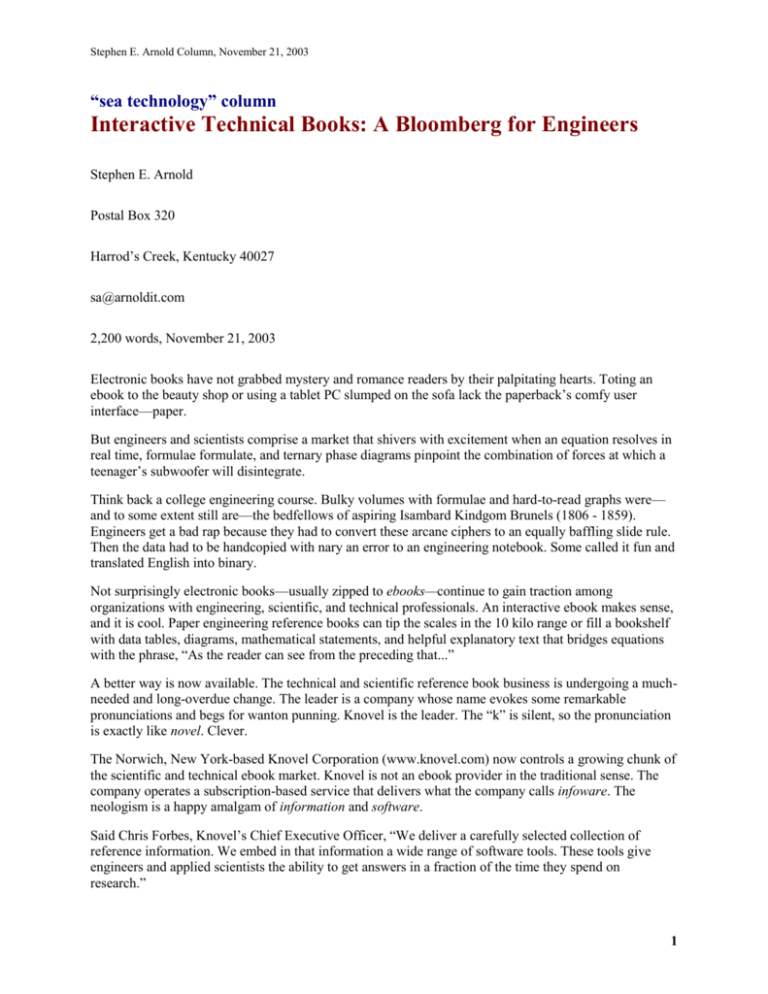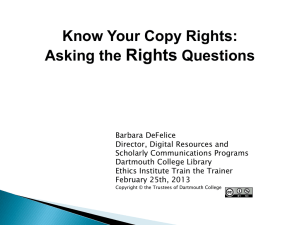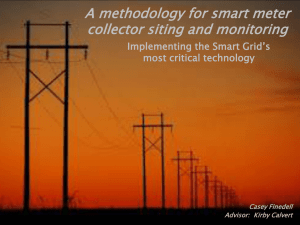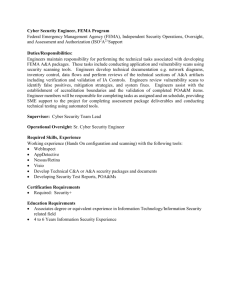Interactive Technical Books: Knovel`s Clever Idea
advertisement

Stephen E. Arnold Column, November 21, 2003 “sea technology” column Interactive Technical Books: A Bloomberg for Engineers Stephen E. Arnold Postal Box 320 Harrod’s Creek, Kentucky 40027 sa@arnoldit.com 2,200 words, November 21, 2003 Electronic books have not grabbed mystery and romance readers by their palpitating hearts. Toting an ebook to the beauty shop or using a tablet PC slumped on the sofa lack the paperback’s comfy user interface—paper. But engineers and scientists comprise a market that shivers with excitement when an equation resolves in real time, formulae formulate, and ternary phase diagrams pinpoint the combination of forces at which a teenager’s subwoofer will disintegrate. Think back a college engineering course. Bulky volumes with formulae and hard-to-read graphs were— and to some extent still are—the bedfellows of aspiring Isambard Kindgom Brunels (1806 - 1859). Engineers get a bad rap because they had to convert these arcane ciphers to an equally baffling slide rule. Then the data had to be handcopied with nary an error to an engineering notebook. Some called it fun and translated English into binary. Not surprisingly electronic books—usually zipped to ebooks—continue to gain traction among organizations with engineering, scientific, and technical professionals. An interactive ebook makes sense, and it is cool. Paper engineering reference books can tip the scales in the 10 kilo range or fill a bookshelf with data tables, diagrams, mathematical statements, and helpful explanatory text that bridges equations with the phrase, “As the reader can see from the preceding that...” A better way is now available. The technical and scientific reference book business is undergoing a muchneeded and long-overdue change. The leader is a company whose name evokes some remarkable pronunciations and begs for wanton punning. Knovel is the leader. The “k” is silent, so the pronunciation is exactly like novel. Clever. The Norwich, New York-based Knovel Corporation (www.knovel.com) now controls a growing chunk of the scientific and technical ebook market. Knovel is not an ebook provider in the traditional sense. The company operates a subscription-based service that delivers what the company calls infoware. The neologism is a happy amalgam of information and software. Said Chris Forbes, Knovel’s Chief Executive Officer, “We deliver a carefully selected collection of reference information. We embed in that information a wide range of software tools. These tools give engineers and applied scientists the ability to get answers in a fraction of the time they spend on research.” 1 Stephen E. Arnold Column, November 21, 2003 Knovel’s ebooks are interactive. Here’s how it works. A reader reviews the content in HTML or PDF format. When an equation catches her eye, the engineer’s mouse click activates and the equation accepts the user’s input. In short, the tables, graphs, and equations are interactive behaving like a computer game for adults who love calculating material deterioration values given a specific current throughput. Knovel makes it possible for an engineer or scientist to look up a value or equation, plug in the data, and calculate the result. No more lugging a doorstop to one’s desk, copying data, and crafting a solution. Knovel eliminates the error-fraught and time-consuming task of creating the equation in Excel, Wolfram Mathematica, or—cost control and accountants be damned—writing a program to spit out a needed result. (Yes, engineers make errors. That’s why bridges collapse and your Honda’s drive belt fails.) He added, “Knovel is ‘Bloomberg’ for engineers and scientists.” The average engineer spends more than eight hours per week researching external information, according to an Outsell report published in 2002. Mr. Forbes noted, “In the U.S. eight hours per week translates into $22 billion in costs. Knovel users report that with infoware, one to two hours per week per professional can be saved.“ The company has converted a number of important engineering and technical reference books and databases from John Wiley & Sons, McGraw-Hill, Elsevier, Wolters Kluwer, Springer, specialty publishers such as Industrial Press, and some professional associations such as the American Society of Mechanical Engineers and the Royal Society of Chemistry. Titles include such heart-stoppers as Buried Pipe Design, Radar Design Principles, and my favorite Corrosion of Glass, Ceramics and Ceramic Superconductors, among others. Knovel focuses on the “bibles” in key engineering disciplines. Titles come from most engineering and technical disciplines. Knovel has not equaled the graphics of Microsoft’s Xbox, but when it comes to adrenaline releasing excitement, engineers and scientists are happy with Knovel’s products. One French chemical engineer told me, “Les produits de Knovel sont trés okay.” In French chemical engineering-speak, this phrase means, “I need my nitroglycerin tablet. I am experiencing a hyperacute T wave because. Knovel’s products excite me.” William A. Woishnis, Chairman and Editor-in-Chief told me, “Our proprietary architecture is the key. We input selected content from the original book and add metadata to make some parts of the ebook interactive. Once the data have been encoded in the database, we are able to call them from the PDF files and create the live graphs, the interactive equations, and the other features of the book.” He said, “We created an architecture that is not commercially available. The architecture is unique in that it is universal. It is able to store all types of data including graphics, text, numerical values.” The technology is sufficiently unique that Knovel has sought patent protection and has patents pending. He continued, “Knovel is one large relational database, each discreet piece of content (for instance, monograph, handbook, database, conference proceeding) is presented as a book with a table of contents. This approach is entirely unique. Databases that have never existed in print are presented with a book cover and a TOC that users can browse. Our approach supports the interactive features that we create for each of our products. Interactivity is our secret sauce.” According to the company, Knovel’s technology has evolved over 14 years. The original database architecture for Knovel, was developed by William Woishnis and Sasha Gurke (Knovel’s Vice President of Product Development), who spent 15 years working for Chemical Abstracts Services. Knovel’s toolkit was first applied to floppy discs, then CD-ROMs, and now in online systems. “We had a good idea, but we have continued to refine and enhance the Knovel architecture. The value of continuous improvement 2 Stephen E. Arnold Column, November 21, 2003 is one of the keys to Knovel’s success,” added Mr. Woishnis. “We learned early on that we needed to link our service to the work processes of our users. For instance, the value of a database of a technical reference book like Perry’s Chemical Engineers’ Handbook, a McGraw-Hill title, is increased by giving users the look and feel of a book they have used for decades and the functionality of a database. This is why all our content has the look and feel of a book even if they have only existed in electronic database form before we created a Knovel version. Knovel merges the database and ebook paradigms.” Why does the world need electronic publishing platform? Mr. Woishnis, an engineer replied, “None of the commercial products allowed us to create the type of interactivity that engineers and scientists require. We can interface with any of the mainstream products, and we can integrate into the type of live document environments that are being offered by Adobe Corporation, Sun Microsystems, and Microsoft Corporation, among others. We created our Knovel Reader specifically to display HTML format in a similar way to displaying the PDF format. We can process XML, just about anything a publisher provides.” The idea for the interactive engineering and technical book was, according to Mr. Woishnis, “Obvious. There have been many attempts to create an ebook that accessed various functions. A person can build a Microsoft Word document and access an Excel formulae in a number of different ways. None of the previous attempts provided the engineer or the scientist with the type of reference material plus interactivity in a format that is part of the engineer’s basic way of working.” According to Knovel executives, the firm is growing rapidly. Although Knovel is a service that focuses its attention on applied scientists and engineers, Mr. Woishnis said, “We are now expanding into adjacent markets. For example, large drug companies use knovel to support their chemical process needs as well as applying it to drug discovery. We are able to embed our software tools in a wide range of content.” He added, “This means we can embed content that lets an Intranet user find and analyze information. These data can then be pulled into their workflow. Using Knovel technology in this way is new, very exciting, and challenging. We get high marks for customer support, but we just dive right in to solve technical problems because that’s what we do.” Knovel told me that the company has a laundry list of content to add to their database. On that list are technical conference proceedings, large databases, content from professional societies, and more workflow and Intranet content. “We are building two or three new tools every quarter,” said Mr. Woishnis. “There seems to be a place for Knovel’s approach to information. Our emphasis continues to be on growing usage by technical professionals in industry. Knovel technology fits where access and analysis are needed in the course of everyday tasks.” One downside of Knovel’s approach seems to be the editorial task of tagging content for inclusion in the Knovel database. Once that is completed, programmers and technical specialists must convert a static image into a dynamic object. Mr. Woishnis replied, “Yes, there is work involved in making an equation resolve. We have developed a content management system to convert or load content on the Web. This technology and software are portable and our production capacity is continually improving. We can provide our content tools to publishers so they can put their content on Knovel. However, publishers cannot use our software to put their content on someone else’s site because it is customized to Knovel's server based technology. Knovel's technology helps our publishing partners put their electronic files up on Knovel once they have created these e-files off of their book, database or document production systems.” Many electronic publishers have watched their financials shrivel as corporations make distinctions between must-have and nice-to-have information. Knovel focuses on the must-have category. As a result, Knovel enjoys brisk sales and the attention of many publishers. 3 Stephen E. Arnold Column, November 21, 2003 Mr. Woishnis said, “Knovel's licensing arrangement with its publishing partners provides significant benefits. First of all, Knovel has a significant footprint in the corporate market and we offer our publishing partners a new distribution channel and new annual, renewable revenue streams, in new markets.” Publishers find our approach to security refreshing,” added Mr. Woishnis, “Our digital rights management and security measures include user name / password protected access to content; IP range recognition as a prerequisite for access; access on a subscription basis for a limited number of concurrent users; monitoring of usage to ensure that large downloads of content do not occur; splitting of electronic files to make downloading of a large amount of content difficult; and disabling access by bot software that can download entire Web sites. A possible downside to Knovel’s technology is that it requires the user to have “helper” applications to make use of some of Knovel’s interactive features such as “live” equations. A Knovel user may have to have the Sun Java plug-in 1.3 or higher, Adobe Acrobat Reader 4.05 or higher and Flash Player 6 or higher. In addition, users need Excel 2000 or higher, Internet browsers Netscape 4.7 or higher (7.x versions or higher for best results) or Internet Explorer 5.0.1. Knovel offers a Java or Flash option to its users. Mr. Woishnis said, “We implemented the option of using Java or Flash versions of Knovel tools because users were having firewall issues when only Java versions of these features were available.” Is Knovel the next big thing in STM publishing? Knovel blends market sector expertise with products that provide users with must-have features. Knovel’s innovation path diverges sharply with that of traditional electronic publishers who are rushing to sell consulting and professional services for portals or disguise their content roots in application server integration. Knovel is going in a—well, I avoided the homonym earlier—novel way. The oligopolistic dinosaurs are lumbering into another. I would put my money on Knovel, not an addled Pachycephalosaurs nibbling snow flakes. Knovel Corporation - www.knovel.com 30 Main Street Danbury, CT Phone: 203-748-6066 Fax: 203-748-4854 www.knovel.com Cut line for screenshot: TABLECONTENTS.TIF: A Knovel book displays a list of contents with the interactive elements marked by an icon. Clicking on the entry displays the contents and the interactive component. Cut line for screenshot:: GRAPH.TIF: The interactive workspace appears next to the illustration appearing in the ebook. The user enters the values and the solution and graph for that set of values appears in the display area of the interactive control panel. 4








